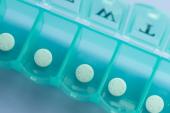Ideal Aspirin Dose in Secondary Prevention Doesn’t Differ Much by Sex
The results, from the ADAPTABLE trial, suggest that women can do well with either 81 mg or 325 mg, Catherine Benziger says.

Both women and men with atherosclerotic cardiovascular disease (ASCVD) who take aspirin as secondary prevention fare just as well, for the most part, whether they’re on 81 mg or 325 mg daily, according to sex-specific analyses from the ADAPTABLE randomized trial.
Catherine P. Benziger, MD (Essentia Health, Duluth, MN), lead author of the study, which was published online Wednesday in JAMA Cardiology, said they were curious to see if the known differences in aspirin metabolism by sex might have an impact on safety and effectiveness. “Aspirin, to me, is the least controversial of the meds for secondary prevention” and taken widely, so it’s an area ripe for further study, she explained.
Aspirin works through multiple mechanisms: by inhibiting cyclooxygenase 1 (COX-1) pathways as well as COX-1–independent pathways. Prior research has shown the latter are inhibited to a lesser extent in women. And while aspirin does appear to have a differential effect for male versus female patients as primary prevention (where its use has since fallen out of favor in clinical guidelines thanks to the negative ASPREE, ARRIVE, and ASCEND trials), these sex discrepancies have yet to be explored in the realm of secondary prevention.
The ADAPTABLE trial is unique, said Benziger, in that it was able to enroll a sizeable proportion of women—31%—thanks to its roots in the Patient-Centered Outcomes Research Institute (PCORI) clinical research network (PCORnet).
“Traditionally in clinical trials, women are underrepresented,” she observed. “Women are undertreated for both primary and secondary prevention: we’re not as aggressive at treating their blood pressure, treating their lipids, and once they have a heart attack, we don't get them as aggressively on dual antiplatelet therapy, get their cholesterol down, [etc].” Some of this undertreatment is thanks to bias in medicine and some of it is due to the fact that “a lot of our research has been largely done on men, and [it’s possible] women don't react the same way to some of the medications and things,” Benziger commented.
Similar Effectiveness but an Unusual Safety Outcome
ADAPTABLE's main results, published in the New England Journal of Medicine in 2021, showed that 81 mg aspirin is just as effective as 325 mg at preventing major cardiovascular events, and both doses are associated with a very low rate of bleeding.
The trial enrolled 15,076 participants with established ASCVD across 40 centers and one health plan. Slightly less than half (48.8%) of the trial’s 4,724 women were randomized to an aspirin dose of 81 mg and the rest to 325 mg. Notably, though, adherence to the assigned study drug was spotty—13.4% of women and 10.3% of men originally in the 81-mg group switched or discontinued their dose, as did 41.8% and 42.4%, respectively, of those originally in the 325-mg dose.
Female participants tended to be younger than those who were male and were less likely to self-identify as white, more likely to smoke, and more often had a history of peripheral arterial disease.
Over a median follow-up of 26.2 months, there was no interaction by sex for the study’s primary endpoint—all-cause death and hospitalization for MI or stroke—between women and men (8.1% vs 7.1%, respectively; P for interaction = 0.74). While the rates of all-cause death and hospitalization for MI were similar for the two sexes, women were more likely to be hospitalized for stroke than men (1.94% vs 0.97%; P for interaction < 0.001) and were less likely to undergo revascularization with PCI or CABG (4.98% vs 6.60%; P for interaction = 0.002).
Women assigned to the 81-mg dose, compared with the 325-mg dose, had a slightly lower likelihood of dying (adjusted HR 0.73; 95% CI 0.55-0.99) but no difference in the primary endpoint. For men, the dose did not appear to influence effectiveness.
Rates of major bleeding, the study’s primary safety outcome, were similar between women and men (0.69% vs 0.60%). Yet major bleeding, counterintuitively, was slightly more common in women assigned to 81 mg aspirin versus 325 mg (0.83% vs 0.52%; adjusted HR 2.21; 1.04-4.70). Again, men saw no difference by dose.
Benziger said the finding of more bleeding among women at the lower dose can likely be explained by background medication use. Patients could not be on anticoagulation when they enrolled, but if they developed atrial fibrillation or another indication during the study, they could begin to take it at a later date—this combination of anticoagulant and antiplatelet therapy would affect bleeding risk, so many patients originally randomized to receive 325 mg would have likely switched to the 81 mg.
Unfortunately, there’s a lack of data tracking either this or the use of dual antiplatelet therapy, she added. “So to me, the higher bleeding rate is likely not because of the aspirin, but probably because of other factors that were not adequately captured in our data collection of the pragmatic trial.”
Practice is “a huge mix,” for both men and women, when it comes to aspirin dosing in secondary prevention, Benziger said. Indeed, as the paper notes, “none of the primary or secondary prevention guidelines provide sex-specific recommendations on aspirin use or dosage but encourage shared decision-making between patient and clinician.”
In today’s world, as it has been for decades, “aspirin is still very much a mainstay,” she noted. But the search for an optimal dose may become less relevant as antithrombotic regimens evolve and the implications for particular subgroups, such as patients with atrial fibrillation or diabetes, are better understood.
Based on their findings, “at this point, [it seems] whatever aspirin dose you were on was probably fine, Benziger specified. “If you asked my opinion, probably I would go with the 81 milligram now, but [with the caveat that] for women there seemed to be a slightly higher risk of bleeding. Now, is that related to the 81 milligrams? Probably not.”
Caitlin E. Cox is News Editor of TCTMD and Associate Director, Editorial Content at the Cardiovascular Research Foundation. She produces the…
Read Full BioSources
Benziger CP, Stebbins A, Wruck LM, et al. Aspirin dosing for secondary prevention of atherosclerotic cardiovascular disease in male and female patients: a secondary analysis of the ADAPTABLE randomized clinical trial. JAMA Cardiol. 2024;Epub ahead of print.
Disclosures
- This work was supported through an award from PCORI with additional funding provided by Bayer.
- Benziger reports no relevant conflicts of interest.





Comments